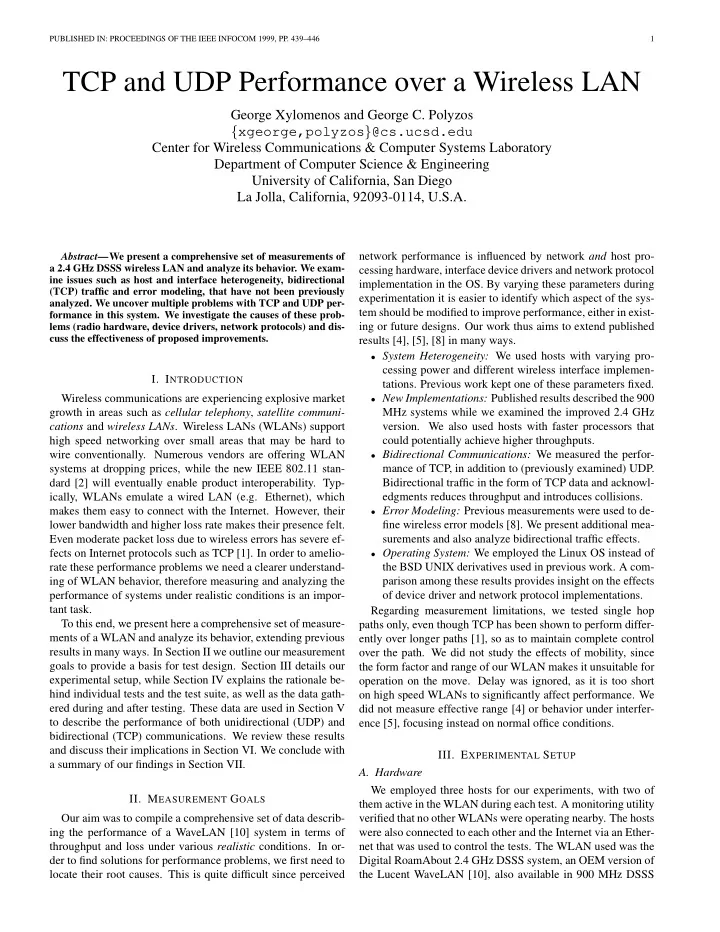

PUBLISHED IN: PROCEEDINGS OF THE IEEE INFOCOM 1999, PP. 439–446 1 TCP and UDP Performance over a Wireless LAN George Xylomenos and George C. Polyzos { xgeorge,polyzos } @cs.ucsd.edu Center for Wireless Communications & Computer Systems Laboratory Department of Computer Science & Engineering University of California, San Diego La Jolla, California, 92093-0114, U.S.A. network performance is influenced by network and host pro- Abstract —We present a comprehensive set of measurements of a 2.4 GHz DSSS wireless LAN and analyze its behavior. We exam- cessing hardware, interface device drivers and network protocol ine issues such as host and interface heterogeneity, bidirectional implementation in the OS. By varying these parameters during (TCP) traffic and error modeling, that have not been previously experimentation it is easier to identify which aspect of the sys- analyzed. We uncover multiple problems with TCP and UDP per- tem should be modified to improve performance, either in exist- formance in this system. We investigate the causes of these prob- ing or future designs. Our work thus aims to extend published lems (radio hardware, device drivers, network protocols) and dis- cuss the effectiveness of proposed improvements. results [4], [5], [8] in many ways. • System Heterogeneity: We used hosts with varying pro- cessing power and different wireless interface implemen- I. I NTRODUCTION tations. Previous work kept one of these parameters fixed. Wireless communications are experiencing explosive market • New Implementations: Published results described the 900 growth in areas such as cellular telephony , satellite communi- MHz systems while we examined the improved 2.4 GHz cations and wireless LANs . Wireless LANs (WLANs) support version. We also used hosts with faster processors that high speed networking over small areas that may be hard to could potentially achieve higher throughputs. wire conventionally. Numerous vendors are offering WLAN • Bidirectional Communications: We measured the perfor- systems at dropping prices, while the new IEEE 802.11 stan- mance of TCP, in addition to (previously examined) UDP. dard [2] will eventually enable product interoperability. Typ- Bidirectional traffic in the form of TCP data and acknowl- ically, WLANs emulate a wired LAN (e.g. Ethernet), which edgments reduces throughput and introduces collisions. makes them easy to connect with the Internet. However, their • Error Modeling: Previous measurements were used to de- lower bandwidth and higher loss rate makes their presence felt. fine wireless error models [8]. We present additional mea- Even moderate packet loss due to wireless errors has severe ef- surements and also analyze bidirectional traffic effects. fects on Internet protocols such as TCP [1]. In order to amelio- • Operating System: We employed the Linux OS instead of rate these performance problems we need a clearer understand- the BSD UNIX derivatives used in previous work. A com- ing of WLAN behavior, therefore measuring and analyzing the parison among these results provides insight on the effects performance of systems under realistic conditions is an impor- of device driver and network protocol implementations. tant task. Regarding measurement limitations, we tested single hop To this end, we present here a comprehensive set of measure- paths only, even though TCP has been shown to perform differ- ments of a WLAN and analyze its behavior, extending previous ently over longer paths [1], so as to maintain complete control results in many ways. In Section II we outline our measurement over the path. We did not study the effects of mobility, since goals to provide a basis for test design. Section III details our the form factor and range of our WLAN makes it unsuitable for experimental setup, while Section IV explains the rationale be- operation on the move. Delay was ignored, as it is too short hind individual tests and the test suite, as well as the data gath- on high speed WLANs to significantly affect performance. We ered during and after testing. These data are used in Section V did not measure effective range [4] or behavior under interfer- to describe the performance of both unidirectional (UDP) and ence [5], focusing instead on normal office conditions. bidirectional (TCP) communications. We review these results and discuss their implications in Section VI. We conclude with III. E XPERIMENTAL S ETUP a summary of our findings in Section VII. A. Hardware We employed three hosts for our experiments, with two of II. M EASUREMENT G OALS them active in the WLAN during each test. A monitoring utility Our aim was to compile a comprehensive set of data describ- verified that no other WLANs were operating nearby. The hosts ing the performance of a WaveLAN [10] system in terms of were also connected to each other and the Internet via an Ether- throughput and loss under various realistic conditions. In or- net that was used to control the tests. The WLAN used was the der to find solutions for performance problems, we first need to Digital RoamAbout 2.4 GHz DSSS system, an OEM version of locate their root causes. This is quite difficult since perceived the Lucent WaveLAN [10], also available in 900 MHz DSSS
Recommend
More recommend